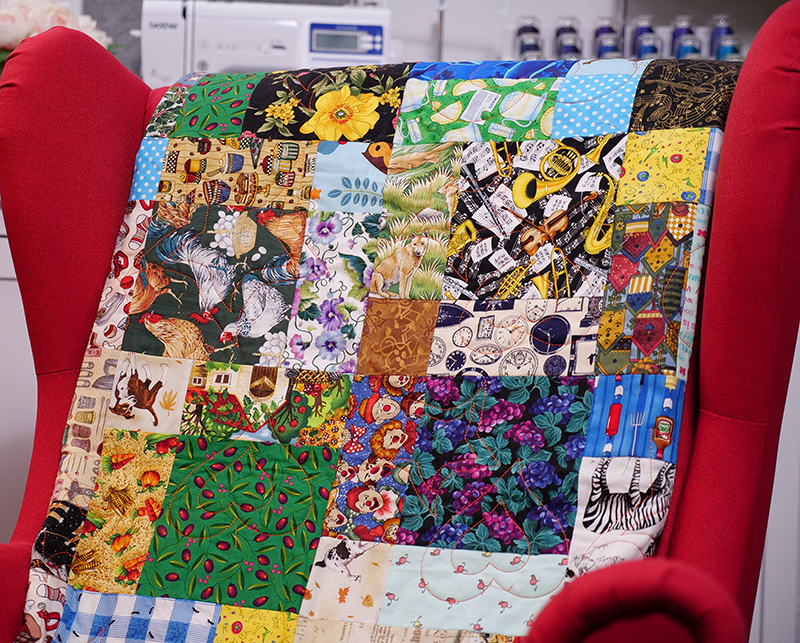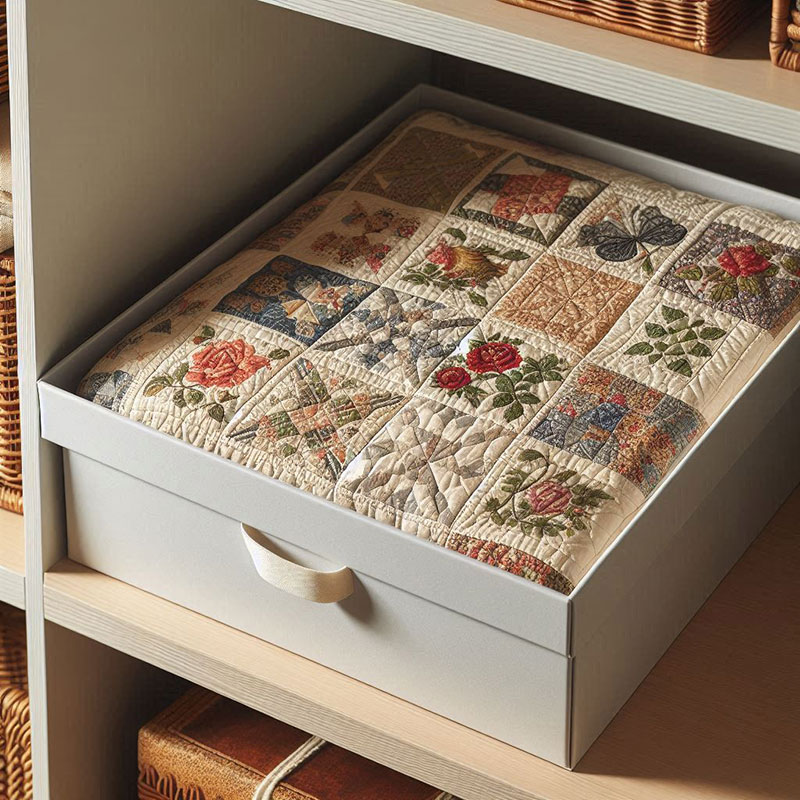Quilt Care
Date Posted:16 October 2024
A quilt can hold a lot of sentimental value, whether you have made it yourself, received it as a gift, or gifted someone else with a treasured piece. Caring for a quilt is preserving its beauty and longevity for the next generation. In this article, we will provide you with expert tips and tricks on how to care for your quilts, ensuring that they stay in pristine condition for years to come. Believe it or not, quilts are robust and will survive many generations with proper quilt care.
Why is proper quilt care important?
Quilts are often made with natural fabrics and can be stitched by hand or machine. By following the right care practices, you can prevent damage and deterioration over time. One of the main reasons why quilt care is important is to prevent the buildup of dust, dirt, and other particles that can accumulate on the surface of the quilt. Regular cleaning and maintenance help remove these particles, keeping your quilt fresh and vibrant.
Lastly, caring for your quilts ensures that they remain beautiful and functional for future generations to enjoy. By maintaining their condition, you can continue the tradition of sharing your quilt's warmth and stories with your loved ones.
Understanding different types of quilts
Before diving into the specifics of quilt care, it's important to understand the different types of quilts you may encounter. Quilts come in various styles, designs, and construction methods, each requiring specific care techniques.
Patchwork quilts are common and are made by sewing together small fabric pieces to create a larger design. These quilts often have intricate patterns and can be machine or hand-stitched. Applique quilts feature fabric pieces that are sewn onto a base fabric, creating a decorative design or scene. The applique pieces can be stitched by machine or hand which may require extra care to prevent damage to the delicate stitching.
Art quilts are unique and often experimental in design. They incorporate various techniques and materials, including fabric painting, beading, and embroidery. Due to their artistic nature, art quilts may require specialised care and cleaning methods.

Patchwork Quilt
Vintage or antique quilts are valuable pieces of history and require extra care to preserve their integrity. These quilts may have fragile fabrics, delicate stitching, and age-related damage. When caring for vintage or antique quilts, it's important to handle them with extra care to minimise deterioration.
By understanding the different types of quilts, you can tailor your care routine to suit the specific needs of your quilt/s.
Cleaning and washing your quilt
A bed quilt doesn’t require regular washing, at most they may be washed twice a year. A quilt that is used as a throw rug on the lounge, or a baby’s blanket on the floor would require more frequent washing.
The method used to launder the quilt is usually determined by the density of the quilting. If the quilt is ‘heavily quilted’ the item can be washed in the washing machine using a wool washing liquid on a gentle wool/delicate cycle. This quilt can then be hung to dry on a clothes rack, or outside on a clothesline.

If you are unsure whether your quilt fits the criteria of ‘heavily quilted’ the next alternative would be to wash the quilt by hand. To use this method, place the quilt in the bath with wool washing liquid and fill with warm water until it is just covered. Then, stand in the bath and walk over the quilt to agitate it with your feet, much like stomping grapes to make wine, except we are stomping the quilt to clean it.
Next drain the water, then refill the bath with warm water and soak the quilt again removing the wool wash residue. You may need to do some more stomping to move the water gently through the quilt, or gently push the quilt with your hands. This step may need to be completed a couple of times until the water runs clear. To remove the excess water, gently squeeze the quilt by hand, or roll the quilt in towels to absorb the moisture. The quilt will be quite heavy and it may take a little longer to squeeze and remove the water using this method.
An alternative would be using the spin cycle on your washing machine. The spin speed is the speed at which the washing machine tub spins when in the final cycle, removing the excess water. When setting the machine for a particular fabric type the machine will usually default to a specific spin cycle. If you are using this method, choose a wool spin cycle which is a slower spin speed, this will remove the excess water without wringing out the quilt.
The quilt can now be hung to dry on a clothes rack or outside on a clothesline. It’s important the quilt is exposed to consistent airflow and this can be achieved by hanging the quilt over multiple lines to spread the weight, and if possible hang them lengthwise.
Not all quilts can withstand this style of cleaning. If you have a vintage or antique quilt, or a quilt with intricate applique or embroidery, it may be best to spot clean any marks using a baby wipe and simply hang the quilt on a clothes rack or clothes in the open air, rotating throughout the day to maximize airflow on each side.
Preparing your quilt for storage
Once the quilt is clean, it's important to ensure it is completely dry before storing. Quilts should folded to a smaller footprint. Avoid folding the quilt tightly as it can cause permanent creases in the fabric. Place the folded quilt in a clean, breathable storage container, such as a cotton bag or acid-free box.
Remember to avoid storing your quilt in plastic bags or containers, as they can trap moisture and promote mold growth. Additionally, keep the storage container in a cool, dry place away from direct sunlight and fluctuating temperatures.
Storing your quilt properly
As mentioned earlier, it's important to store your quilt in a clean, breathable container. Cotton bags or acid-free boxes are ideal for long-term storage, as they allow air circulation while preventing dust and pests from entering.
When choosing a storage location, aim for a cool, dry place away from direct sunlight and fluctuating temperatures. Extreme temperature changes can cause the fabric to expand and contract, leading to stress on the fibres.
If you have limited storage space, hanging your quilt can be an option. However, it's important to use a padded hanger covered in clean, white cotton fabric to prevent creasing and stress on the fabric. Avoid hanging quilts in direct sunlight or near sources of heat or moisture.

Regularly inspect your stored quilt to ensure it remains in good condition. Check for signs of pests, mould, or mildew growth. If you notice any issues, take immediate action to prevent further damage. It's also a good practice to refold the quilt periodically to prevent permanent creases from forming in the same areas.
By following proper storage practices, you can protect your quilt from environmental damage and ensure its longevity.
Final tips for quilt care
Caring for your quilts is not only about preserving their beauty but also honouring their history and craftsmanship. By following these techniques for cleaning & storing, you can ensure that they remain in excellent condition for years to come. Here are some final tips for quilt care:
- When handling your quilts, make sure your hands are clean to avoid transferring dirt, oils, or other substances onto the fabric.
- Avoid excessive folding: Folding quilts repeatedly can cause stress on the fabric and lead to permanent creases. If possible, store quilts flat or roll them instead of folding.
- Inspect regularly: Regularly inspect your quilts for any signs of damage, such as loose threads, tears, or insect infestation.
- Document the quilt's history: If your quilt has a significant history or sentimental value, consider documenting its story. Include information such as the maker, date, and any special details or memories associated with the quilt. This documentation can be passed down along with the quilt, enhancing its value and significance.
By implementing these tips and being mindful of how you care for your quilts, you can ensure that they remain cherished heirlooms for generations to come. Proper quilt care not only preserves their beauty but also honors the craftsmanship and love that went into creating these remarkable pieces of art.


